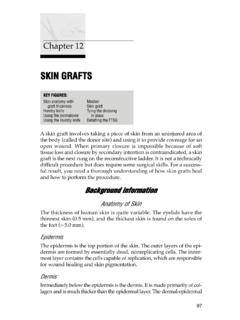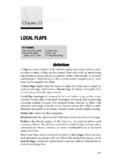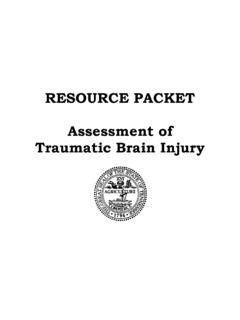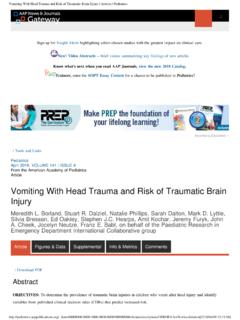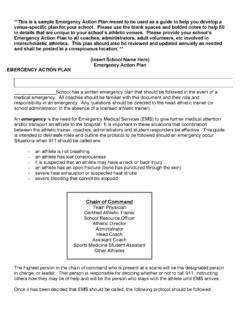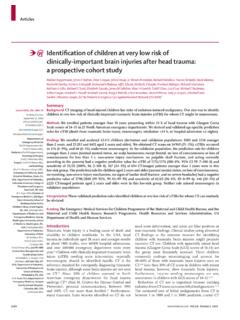Transcription of TRAUMATIC HAND AND FINGER AMPUTATIONS
1 TTRRAAUUMMAATTIICC HHAANNDDAANNDDFFIINNGGEERRAAMMPPUUTTAATT IIOONNSSThis chapter outlines the basic principles for the evaluation and treatmentof TRAUMATIC hand and FINGER AMPUTATIONS proximal to the distal inter-phalangeal (DIP) joint. AMPUTATIONS distal to the DIP joint can be treatedas a fingertip injury (see chapter 29, Fingertip and Nail Bed Injuries ).The procedure to reattach an amputated part is highly technical and te-dious. It includes reconnecting blood vessels (both an artery and atleast one vein), nerves, and lacerated tendons as well as realigning andstabilizing the bones. A highly trained microsurgeon with access tospecialized equipment is NNoo PPrrooppeerrllyy EEqquuiippppeedd MMiiccrroossuurrggeeoonn iiss AAvvaaiillaabblleeYour best strategy is to help the wound heal with as little functionaldisability as possible. You can take steps to prevent, for example, apainful stump, which will interfere with use of the Wound TreatmentAfter administering a digital block or wrist block, as indicated by thelevel of amputation, completely clean and examine both the stump andthe amputated part (see chapter 6, Evaluation of an Acute Wound ).
2 Exposed tendons that have lost their distal insertion sites should be cutoff so that the ends of the tendons are covered by soft not discard the amputated part until you have thoroughly exam-ined the wound. You may be able to use some of the skin from the am-putated segment as a skin graft to cover the open 31 KKEEYY FFIIGGUURREESS::Care of amputated segmentAmputation of the middle fingerSuccessful replantation304 Practical Plastic Surgery for NonsurgeonsOptions for Wound ClosureIf enough skin is available, close the wound with a few loose sutures. Atight closure can lead to further tissue no skin is available, no bone or tendon is exposed, and the wound isrelatively small (< 2 cm), the wound can be left open and treated withlocal care. An alternative is to use noninjured skin from the amputatedsegment as a full-thickness skin graft to cover the the wound is large and cannot be closed primarily or if bones orintact tendons are exposed, a distant flap ( , chest flap, groin flap) isneeded for wound closure.
3 (See chapter 14, Distant Flaps. )If a nerve is exposed at the end of the stump, place a clamp on thenerve and pull gently. Then cut the nerve back to the point where itexits the soft tissues. This maneuver allows the nerve to retract underhealthy skin or soft tissue and thus prevents development of a sensi-tive or painful CareClean with gentle soap and water or sterile saline daily. Strongly urge the patient not to smoke. The patient should keep the affected hand elevated to decreaseswelling and pain and to promote pain medication. Acetaminophen alone may not be enoughfor the first few days after injury. AMPUTATIONS can be quite antibiotic ointment and a simple, dry dressing 1 2 dressings also can be useful. If the wound was sutured closed, after a few days the dressings canbe discontinued. If the wound was left open, continue the dressing changes until thewound is the patient to move the FINGER and hand to prevent jointstiffness.
4 Active and passive range-of-motion exercises also should aa PPrrooppeerrllyy EEqquuiippppeedd MMiiccrroossuurrggeeoonn iiss AAvvaaiillaabblleeYou can take several important steps before the patient is transferred tothe microsurgeon s care. An amputated hand or FINGER (s) can be re-planted even many hours after the injury, but the amputated part mustreceive proper care. TRAUMATIC Hand and FINGER AMPUTATIONS 305In addition, the patient must be informed that he or she will notawaken from surgery with a normally functioning hand. Replantationof the amputated segment commits the patient to a long and tediousrehabilitation program to obtain maximal hand function. Be sure to ex-plain this prolonged process to the intravenous (IV) fluids(normal saline or Ringer s lac-tate) to keep the patient hydrated. While awaiting surgery, the pa-tient should not be allowed to eat or drink anything except aspirin(not acetaminophen) at a dose of 80 160 mg, which isequivalent to one baby aspirin or one-half of an adult aspirin.
5 It canbe given by mouth or as a rectal suppository. The antiplatelet prop-erties of aspirin may help to prevent clotting of the vessels after thereattachment has been a dose of IV first-generation cephalosporin ismost painwith IV morphine or a digital block. Give the nerveblock only after consultation with the and dress the stumpwith saline-moistened gauze (damp, notsoaking wet), and wrap the stump lightly with dry gauze to controloozing and to keep the wound elevatethe affected a radiographof the stump as well as the amputated of the Amputated any foreign materialfrom the exposed soft amputated part with saline, and wrapit in saline moist-ened gauze (damp, not soaking wet).3. Place the wrapped segment in a plastic Place the bag into a container filled with ice mixed with saline. Donot place the amputated part directly on Do not forget to get a radiographof the amputated patient is now ready for M, Dautel G: Advances in digital replantation.
6 Clin Plast Surg 24:87 106, Practical Plastic Surgery for NonsurgeonsCare of the amputated segment. The am-putated segment should be cooled imme-diately by wrapping it in a moist salinegauze, placing it in a sealed plastic bag,and immersing it in an iced saline con-tainer. (From McCarthy J (ed): PlasticSurgery. Philadelphia, Saunders,1990, with permission.) TRAUMATIC amputation of the middle ,Hand with missing , Amputated year after successful replantation. Aand B, Patient has regained excellentfunction of her hand.



